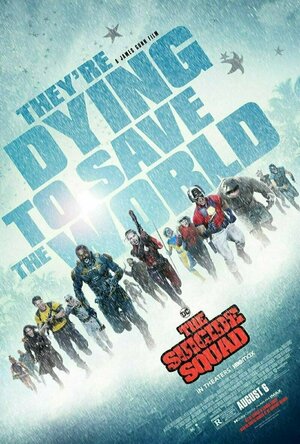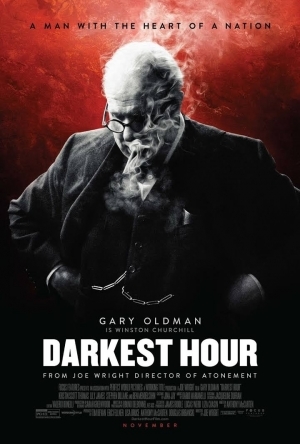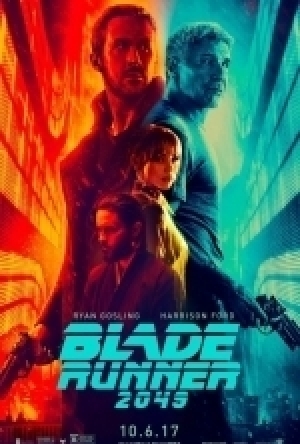Search
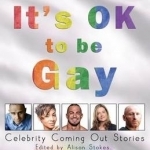
It's Ok to be Gay: Celebrity Coming out Stories
Diversity Role Models and Alison Stokes
Book
Celebrities share their coming out stories Launched to coincide with National Coming Out Day, It's...
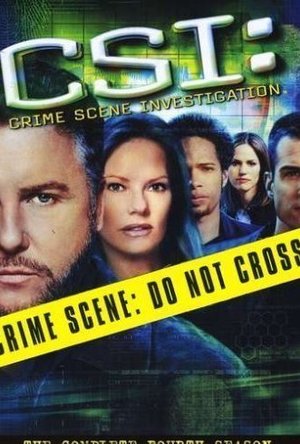
CSI: Crime Scene Investigation - Season 4
TV Season
Nick accidentally leaks information to a news reporter ("Assume Nothing"), and Catherine tries to...
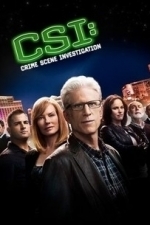
CSI: Crime Scene Investigation - Season 1
TV Season
It's all change at the Las Vegas Crime Lab following the shooting death of Holly Gribbs ("Pilot"),...
Chris Sawin (602 KP) rated The Suicide Squad (2021) in Movies
Oct 6, 2021
Its adult humor is also incredibly poignant (2 more)
Blood and gore is Troma levels of insanity
King Shark and Polka Dot Man
Not as fun on repeat viewings (1 more)
Is a little too similar to Guardians of the Galaxy
I'm a Motherf@#$ing Superhero!
You could probably get away with calling James Gunn’s The Suicide Squad an R-rated version of Guardians of the Galaxy, but it isn’t entirely fair or correct. It’s a complicated comparison much like Gunn’s status with Marvel Studios that allowed him to make the film in the first place and whether or not The Suicide Squad is a sequel or a reboot to David Ayer’s 2016 film.
Gunn has always had a knack for getting gory or gross or raunchy if the opportunity presented itself. The Suicide Squad almost feels like a clean, strike that, blood-splattered slate for the filmmaker. Gunn had complete creative control while making The Suicide Squad and it shows; not only in its graphic content and excessive vulgarity, but also in the characters Gunn chose to be in the film. Nearly everyone has been replaced from the previous Suicide Squad film except for Captain Boomerang (Jai Courtney), Colonel Rick Flagg (Joel Kinnaman), Harley Quinn (Margot Robbie), and Amanda Waller (Viola Davis). The new characters are mostly unknown or barely known villains, which makes the fact that nearly all of them are expendable all the more intriguing.
While Guardians of the Galaxy and The Suicide Squad are two different films, there are some undeniable similarities. The cast of The Suicide Squad is insanely stacked, but you have to know by now that three quarters of these characters die in horribly gruesome ways. Witnessing who lives and who dies is half the fun of the film, so that won’t be spoiled here. But The Suicide Squad has a team of five characters that are grouped together and featured more than anyone else. It’s a lot like how Guardians began with Star-Lord, Gamora, Drax, Rocket, and Groot. These five characters also end up being the ones you love the most.
Gunn also has a thing for taking a group of assholes and giving them meaning. In the tenth season of South Park, Eric Cartman meets Bart Simpson face to face. Bart has always been a troublemaker and a prankster, but Cartman ground up Scott Tenorman’s parents, slapped that ground parent meat in some chili, and made Scott eat his own parents. The comparison between Guardians and The Suicide Squad is a lot like the difference between Bart Simpson and Eric Cartman. The Suicide Squad features straight up murderers, demented psychopaths, and whatever the hell Weasel is.
Not unlike his other comic book film work though, Gunn typically takes what would be unlikable characters on their own and finds a purpose for them once they’re with other outcasts that they can relate to. There is a ton of heart in The Suicide Squad. You fall in love with King Shark because he’s trying to read books upside down and use one of his fingers as mustache as a brilliant disguise, but you don’t feel for him until he reveals that he’s never had a friend. Sebastian, Ratcatcher II’s go-to rat, is adorable because he waves at, offers leaves to, and flocks toward Bloodsport even though he’s afraid of rats. There’s still this camaraderie in The Suicide Squad. It may be broken and gory, but it’s still camaraderie.
There are some unusual choices that Gunn made with The Suicide Squad though. They originally wanted Will Smith to come back as Deadshot, but supposedly cast Idris Elba to replace Smith in the role. Then they backtracked and made Elba Bloodsport. The odd thing is that both Bloodsport and Peacemaker are exactly the same as Deadshot. Peacemaker seems to be a bit crazier, but both characters have a thing for making anything a weapon in their hands and having precise aim. Bloodsport is even doing everything in the film for the sake of his daughter. It gives Warner Bros a chance to bring Smith back as Deadshot down the line, but having all three characters in the same film would be serious overkill.
Harley Quinn’s action sequences in The Suicide Squad are better and more satisfying than anything Margot Robbie has done with the role. Polka Dot Man is low-key the coolest character of the film despite seeing his mom in every person that he meets. Many will likely point to the blood, the gore, and all of the F-bombs shouted mostly among teammates as Gunn cleansing his Marvel/Disney palette so to speak. However, the major difference is Starro. Starro is a giant blue and purple starfish with an eyeball in the middle of his body. He is essentially a kaiju, but he shoots miniature versions of himself out of his armpits which latch onto people’s faces, kills them, and turns their corpses into zombie-like slaves that do his bidding; all while Starro gets bigger and bigger in the process. The abridged version of this starfish heavy explanation is that Starro is fucking terrifying. The entire world is basically on the verge of bowing down to a Godzilla sized starfish that has the ability to shoot armies of himself out of his Goddamn armpits! The MCU featuring a monster or creature of any kind that is that scary is slim to none.
The Suicide Squad is an uproarious extravaganza filled with grotesque nom-noms, full-on naked dick shots, and John Cena in tighty-whities and it’s is the most fun you’ll have with an R-rated comic book film in a theater (or at home with HBO Max) since Deadpool. It’s the first comic book film to come along in a good long while that’s charming because of how weird it is. As a final note, stay/watch after the credits. James Gunn and John Cena are doing an 8-episode Peacemaker TV series for HBO Max due sometime in 2022, so that may or may not be teased in some capacity.
Gunn has always had a knack for getting gory or gross or raunchy if the opportunity presented itself. The Suicide Squad almost feels like a clean, strike that, blood-splattered slate for the filmmaker. Gunn had complete creative control while making The Suicide Squad and it shows; not only in its graphic content and excessive vulgarity, but also in the characters Gunn chose to be in the film. Nearly everyone has been replaced from the previous Suicide Squad film except for Captain Boomerang (Jai Courtney), Colonel Rick Flagg (Joel Kinnaman), Harley Quinn (Margot Robbie), and Amanda Waller (Viola Davis). The new characters are mostly unknown or barely known villains, which makes the fact that nearly all of them are expendable all the more intriguing.
While Guardians of the Galaxy and The Suicide Squad are two different films, there are some undeniable similarities. The cast of The Suicide Squad is insanely stacked, but you have to know by now that three quarters of these characters die in horribly gruesome ways. Witnessing who lives and who dies is half the fun of the film, so that won’t be spoiled here. But The Suicide Squad has a team of five characters that are grouped together and featured more than anyone else. It’s a lot like how Guardians began with Star-Lord, Gamora, Drax, Rocket, and Groot. These five characters also end up being the ones you love the most.
Gunn also has a thing for taking a group of assholes and giving them meaning. In the tenth season of South Park, Eric Cartman meets Bart Simpson face to face. Bart has always been a troublemaker and a prankster, but Cartman ground up Scott Tenorman’s parents, slapped that ground parent meat in some chili, and made Scott eat his own parents. The comparison between Guardians and The Suicide Squad is a lot like the difference between Bart Simpson and Eric Cartman. The Suicide Squad features straight up murderers, demented psychopaths, and whatever the hell Weasel is.
Not unlike his other comic book film work though, Gunn typically takes what would be unlikable characters on their own and finds a purpose for them once they’re with other outcasts that they can relate to. There is a ton of heart in The Suicide Squad. You fall in love with King Shark because he’s trying to read books upside down and use one of his fingers as mustache as a brilliant disguise, but you don’t feel for him until he reveals that he’s never had a friend. Sebastian, Ratcatcher II’s go-to rat, is adorable because he waves at, offers leaves to, and flocks toward Bloodsport even though he’s afraid of rats. There’s still this camaraderie in The Suicide Squad. It may be broken and gory, but it’s still camaraderie.
There are some unusual choices that Gunn made with The Suicide Squad though. They originally wanted Will Smith to come back as Deadshot, but supposedly cast Idris Elba to replace Smith in the role. Then they backtracked and made Elba Bloodsport. The odd thing is that both Bloodsport and Peacemaker are exactly the same as Deadshot. Peacemaker seems to be a bit crazier, but both characters have a thing for making anything a weapon in their hands and having precise aim. Bloodsport is even doing everything in the film for the sake of his daughter. It gives Warner Bros a chance to bring Smith back as Deadshot down the line, but having all three characters in the same film would be serious overkill.
Harley Quinn’s action sequences in The Suicide Squad are better and more satisfying than anything Margot Robbie has done with the role. Polka Dot Man is low-key the coolest character of the film despite seeing his mom in every person that he meets. Many will likely point to the blood, the gore, and all of the F-bombs shouted mostly among teammates as Gunn cleansing his Marvel/Disney palette so to speak. However, the major difference is Starro. Starro is a giant blue and purple starfish with an eyeball in the middle of his body. He is essentially a kaiju, but he shoots miniature versions of himself out of his armpits which latch onto people’s faces, kills them, and turns their corpses into zombie-like slaves that do his bidding; all while Starro gets bigger and bigger in the process. The abridged version of this starfish heavy explanation is that Starro is fucking terrifying. The entire world is basically on the verge of bowing down to a Godzilla sized starfish that has the ability to shoot armies of himself out of his Goddamn armpits! The MCU featuring a monster or creature of any kind that is that scary is slim to none.
The Suicide Squad is an uproarious extravaganza filled with grotesque nom-noms, full-on naked dick shots, and John Cena in tighty-whities and it’s is the most fun you’ll have with an R-rated comic book film in a theater (or at home with HBO Max) since Deadpool. It’s the first comic book film to come along in a good long while that’s charming because of how weird it is. As a final note, stay/watch after the credits. James Gunn and John Cena are doing an 8-episode Peacemaker TV series for HBO Max due sometime in 2022, so that may or may not be teased in some capacity.
Bob Mann (459 KP) rated Darkest Hour (2017) in Movies
Sep 29, 2021
Not buggering it up.
As Doctor Who repeatedly points out, time is most definitely a tricksy thing. As I think I’ve commented on before, the events of 1940-45 are not in my lifetime but were sufficiently fresh to my parents that they were still actively talked about… so they still appear “current” to me. But I find it astonishing to realize that to a teen viewer this film is equivalent in timeframe to the sinking of the Titanic! #ancienthistory! So I suspect your connection to this film will be strongly affected by your age, and that was definitely reflected in the average age at my showing which must have been at least 60.
It’s 1940 and Western Europe is under siege. Neville Chamberlain (Ronald Pickup, “The Second Best Exotic Marigold Hotel“) is the Conservative Prime Minister but is voted out of office in an attempt to form a grand coalition government with Labour leader Clement Atlee (David Schofield). Despite appearing a shoe-in for the role, Viscount Halifax (Stephen Dillane) turns it down, thinking that his alternative (and bête noire) would drink from the poisoned chalice and be quickly be out of his (and Chamberlain’s) hair. For that alternative choice is the volatile and unpredictable Churchill (Gary Oldman), grudgingly invited into the job by King George VI (Ben Mendelsohn, “Rogue One“). With the Nazi’s bearing down on the 300,000 encircled troops at Dunkirk, and with calls from his war cabinet to capitulate and seek terms of settlement, this is indeed both Churchill’s, and the country’s, ‘darkest hour’.
Despite the woeful lack of historical knowledge among today’s youngsters, most will be at least aware of the story of Dunkirk, with many having absorbed Christopher Nolan’s film of last summer. This film is almost the matching bookend to that film, showing the terrifying behind-closed-door events that led up to that miracle. For it was terrifying seeing how close Britain came to the brink, and I’m not sure even I really appreciated that before. While this might have been a “thriller” if it had been a fictional story, we well know the outcome of the story: but even with this knowledge I still found the film to be extremely tense and claustrophobic as the net draws in around Churchill’s firmly-held beliefs.
Gary Oldman’s performance is extraordinary, and his award nominations are well-deserved. We have grown so used to some of his more over-the-top Russian portrayals in films like “Air Force One” and last year’s (pretty poor) “The Hitman’s Bodyguard” that it is easy to forget what a nuanced and flexible actor he is. Ever since that “No, surely not!” moment of that first glimpse of the film’s trailer, it has almost been impossible to ‘see’ Oldman behind the brilliant make-up of the character (Kazuhiro Tsuji gets a special credit for it). But his eyes are in there, and there are some extreme close-ups (for example, during a bizarre and tense phone call with Roosevelt (David Strathairn)) when you suddenly see “There you are!”.
The supportive wife – Clemmie (Kristin Scott Thomas) gives Winston (Gary Oldman) a hug.
While I have nothing against Brian Cox as an actor, I far prefer the portrayal of Churchill on show here compared to last year’s “Churchill“: true that that film was set three or four stressful years later, but Cox’s Churchill was portrayed as an incompetent fool, an embarrassment to the establishment that have to work around him. Oldman’s Churchill is irascible, unreasonable, but undeniably a leader and a great orator.
Mirroring “Churchill” though, the action is seen through the eyes of Churchill’s put-upon secretary, here played delightfully by Lily James (“Downton Abbey”, “Baby Driver“) who perfectly looks and sounds the part. The character is more successful than that of Ella Purnell’s Garrett in that she is given more room to develop her character and for the audience to warm to her. Oldman is getting all the kudos, but Lily James really deserves some for her touching and engaging performance here.
Perfectly cast: Lily James as Churchill’s secretary Elizabeth Layton.
Also in Oldman’s shadow is the always marvelous Kristin Scott Thomas (“Four Weddings and a Funeral”, “The English Patient”) as Clemmie Churchill, expressing all the love and frustration associated with being a long-suffering wife to an over-worked husband in the public service.
At the pen is “The Theory of Everything” writer Anthony McCarten, and I’d like to say its a great script but with most of the best lines (“a sheep in sheep’s clothing” – LoL) coming from Winston himself it’s difficult to tell. Some of the scenes can get a bit laborious and at 125 minutes – though not long by any means – the script could still perhaps have had a nip and tuck here and there.
Where some of this time is well spent though is in some sedate shots of London street life, across two separate scenes panning across everyday folk as the stresses of war start to become more evident. This is just one of the areas where director Joe Wright (“Atonement”, “Pride and Prejudice”) shows considerable panache, ably assisted by the cinematography of Bruno Delbonnel (“Inside Llewyn Davis“): a boy closes his telescope-fingers around Churchill’s plane; a bomb’s eye-view of the beleaguered Brigadier Nicholson in Calais; and – very impressively – the smoky imperiousness of the House of Commons set.
An atmospheric chamber: the recreation of the wartime House of Commons is spectacular (with production design by Sarah Greenwood (“Anna Karenina”, “Atonement”)).
And most-importantly Wright delivers what Christopher Nolan couldn’t deliver in “Dunkirk“: a properly CGI’d vista of hundred of small boats crossing the channel to Dunkirk. Now THAT is a scene that Kenneth Branagh could justly have looked in awe at!!!
There are a number of scenes that require disbelief to be suspended though: the biggest one being a tube train ride – very moving and effective I must say – but one that features the longest journey between any two stations on the District Line than has ever been experienced!
One stop on the District Line via Westminster…. via Harrow-on-the-Hill!
So this is a great film for really reliving a knife-edge moment in British history, and is highly recommended particularly for older viewers. If I’m honest though, between “Darkest Hour”, “Churchill” and John Lithgow’s excellent portrayal in “The Crown” I’m all over portrayals of the great man for a few years. Can we please move on now Hollywood?
It’s 1940 and Western Europe is under siege. Neville Chamberlain (Ronald Pickup, “The Second Best Exotic Marigold Hotel“) is the Conservative Prime Minister but is voted out of office in an attempt to form a grand coalition government with Labour leader Clement Atlee (David Schofield). Despite appearing a shoe-in for the role, Viscount Halifax (Stephen Dillane) turns it down, thinking that his alternative (and bête noire) would drink from the poisoned chalice and be quickly be out of his (and Chamberlain’s) hair. For that alternative choice is the volatile and unpredictable Churchill (Gary Oldman), grudgingly invited into the job by King George VI (Ben Mendelsohn, “Rogue One“). With the Nazi’s bearing down on the 300,000 encircled troops at Dunkirk, and with calls from his war cabinet to capitulate and seek terms of settlement, this is indeed both Churchill’s, and the country’s, ‘darkest hour’.
Despite the woeful lack of historical knowledge among today’s youngsters, most will be at least aware of the story of Dunkirk, with many having absorbed Christopher Nolan’s film of last summer. This film is almost the matching bookend to that film, showing the terrifying behind-closed-door events that led up to that miracle. For it was terrifying seeing how close Britain came to the brink, and I’m not sure even I really appreciated that before. While this might have been a “thriller” if it had been a fictional story, we well know the outcome of the story: but even with this knowledge I still found the film to be extremely tense and claustrophobic as the net draws in around Churchill’s firmly-held beliefs.
Gary Oldman’s performance is extraordinary, and his award nominations are well-deserved. We have grown so used to some of his more over-the-top Russian portrayals in films like “Air Force One” and last year’s (pretty poor) “The Hitman’s Bodyguard” that it is easy to forget what a nuanced and flexible actor he is. Ever since that “No, surely not!” moment of that first glimpse of the film’s trailer, it has almost been impossible to ‘see’ Oldman behind the brilliant make-up of the character (Kazuhiro Tsuji gets a special credit for it). But his eyes are in there, and there are some extreme close-ups (for example, during a bizarre and tense phone call with Roosevelt (David Strathairn)) when you suddenly see “There you are!”.
The supportive wife – Clemmie (Kristin Scott Thomas) gives Winston (Gary Oldman) a hug.
While I have nothing against Brian Cox as an actor, I far prefer the portrayal of Churchill on show here compared to last year’s “Churchill“: true that that film was set three or four stressful years later, but Cox’s Churchill was portrayed as an incompetent fool, an embarrassment to the establishment that have to work around him. Oldman’s Churchill is irascible, unreasonable, but undeniably a leader and a great orator.
Mirroring “Churchill” though, the action is seen through the eyes of Churchill’s put-upon secretary, here played delightfully by Lily James (“Downton Abbey”, “Baby Driver“) who perfectly looks and sounds the part. The character is more successful than that of Ella Purnell’s Garrett in that she is given more room to develop her character and for the audience to warm to her. Oldman is getting all the kudos, but Lily James really deserves some for her touching and engaging performance here.
Perfectly cast: Lily James as Churchill’s secretary Elizabeth Layton.
Also in Oldman’s shadow is the always marvelous Kristin Scott Thomas (“Four Weddings and a Funeral”, “The English Patient”) as Clemmie Churchill, expressing all the love and frustration associated with being a long-suffering wife to an over-worked husband in the public service.
At the pen is “The Theory of Everything” writer Anthony McCarten, and I’d like to say its a great script but with most of the best lines (“a sheep in sheep’s clothing” – LoL) coming from Winston himself it’s difficult to tell. Some of the scenes can get a bit laborious and at 125 minutes – though not long by any means – the script could still perhaps have had a nip and tuck here and there.
Where some of this time is well spent though is in some sedate shots of London street life, across two separate scenes panning across everyday folk as the stresses of war start to become more evident. This is just one of the areas where director Joe Wright (“Atonement”, “Pride and Prejudice”) shows considerable panache, ably assisted by the cinematography of Bruno Delbonnel (“Inside Llewyn Davis“): a boy closes his telescope-fingers around Churchill’s plane; a bomb’s eye-view of the beleaguered Brigadier Nicholson in Calais; and – very impressively – the smoky imperiousness of the House of Commons set.
An atmospheric chamber: the recreation of the wartime House of Commons is spectacular (with production design by Sarah Greenwood (“Anna Karenina”, “Atonement”)).
And most-importantly Wright delivers what Christopher Nolan couldn’t deliver in “Dunkirk“: a properly CGI’d vista of hundred of small boats crossing the channel to Dunkirk. Now THAT is a scene that Kenneth Branagh could justly have looked in awe at!!!
There are a number of scenes that require disbelief to be suspended though: the biggest one being a tube train ride – very moving and effective I must say – but one that features the longest journey between any two stations on the District Line than has ever been experienced!
One stop on the District Line via Westminster…. via Harrow-on-the-Hill!
So this is a great film for really reliving a knife-edge moment in British history, and is highly recommended particularly for older viewers. If I’m honest though, between “Darkest Hour”, “Churchill” and John Lithgow’s excellent portrayal in “The Crown” I’m all over portrayals of the great man for a few years. Can we please move on now Hollywood?
Bob Mann (459 KP) rated Blade Runner 2049 (2017) in Movies
Sep 29, 2021
A stunning visual triumph.
I was a sufficient nerd to buy a “Back to the Future” T-shirt to celebrate “future day” from “Back to the Future 2” two-years ago, and I will probably be a sufficient nerd to buy a “Blade Runner” T-shirt in two-years time to celebrate the setting-date for the original film. One thing’s for sure… 2049 is never going to be long enough away to see the world of the new Blade Runner movie come to fruition: so I look forward to ironically buying that T-shirt too (assuming I make it to 88!). But I digress.
I lived in fear of this film since it was announced… having loved the original, a sequel was always going to be a risky prospect. But my fears were slightly quelled when I learned that Denis Villeneuve (“Arrival“) was at the helm. And having now seen it I am pleasantly relieved: this is a memorable film.
In 2049 the first-generation Nexus replicants of the original film are still causing problems, and Ryan Gosling is ‘K’ – a blade runner employed by LAPD lieutenant Joshi (Robin Wright, “Wonder Woman“, “House of Cards”) to track them down and liquidate them. On one of these missions, K uncovers a buried secret that brings the LAPD into a desperate race for a pivotal prize, against replicant-builder Niander Wallace (Jared Leto, “Dallas Buyer’s Club“) and his henchwoman Luv (Sylvia Hoeks). The mission leads to K searching out his illustrious predecessor Deckard (Harrison Ford), who is not keen to be found.
Firstly (and most impressively) this is a spectacle to watch…. “I’ve seen things…”! The visuals are just gorgeous, from the junk-yards of Greater Los Angeles to the radioactive ruins of Las Vegas, vividly glowing amber to glorious effect. Hardly a surprise with Roger Deakins (“Hail Caesar“, “Sicario“) behind the camera, but Adam Heinis (“Rogue One“) and the rest of his special effects team deserve kudos for the effects never feeling overly “CGI-like”.
The music (by Benjamin Wallfisch and Hans Zimmer, via a replaced Johann Johannsson) pays suitable tribute to the spirit of the original Vangelis soundtrack. (It’s curious though that “Tears in the Rain” from the soundtrack is a reworking of the Vangelis original, but Vangelis doesn’t seem to be credited anywhere! Vangelis and Ridley Scott clearly had a SERIOUS falling out!).
On the acting front, Ryan Gosling is his dynamic self as usual! (But here, somewhat justified). Harrison Ford is given very little screen time, but what he does do he does exceptionally well – his best performance in years. It’s some of the supporting parts though that really appeal: Dave Bautista (“Spectre“) is just superb in the opening scenes of the film, and I particularly enjoyed Ana de Armas’s portrayal of K’s holographic girlfriend Joi. I’ve seen comment in other reviews that described this relationship as “laughable” and a downward step for “woman’s rights” compared to Villeneuve’s previous strong female characters (of Louise from “Arrival” and Kate from “Sicario“). But I disagree! I found the relationship truly touching, with Joi’s procurement of a prostitute (Mackenzie Davis) to act as a surrogate body being both loving and giving. And as regards ‘woman’s rights’, come on! Get serious! This is a holographic commercial male companion…. the “Alexa” of the future…. I’m quite sure the male version looks like Ryan Reynolds! Sex still sells, even in 2049!!
My favourite character though was a cameo by Barkhad Abdi (“Captain Phillips“) luxoriating under the name of Doctor Badger!
I was less comfortable with Jared Leto’s dialogue which – for me at least – was barely audible. In general this film is both a challenge for those aurally challenged (with some fuzzy dialogue/effects/music mixes) and those visually challenged (with 8 point font for the on-screen text that was almost impossible to see on the cinema screen, so good luck with the DVD!).
I really wanted to give this film 5-Fads. But I can’t quite get there. The story – while interesting and having emotional depth – is lightweight for a film of this length (a butt-numbing 163 minutes!) and it moves at such a glacial pace that I’m ashamed to say that my mind wandered at times. (Specifically to how many different ways I could imagine harm being done to the American guy in front of me, who was constantly turning on his Apple watch and at one point (to whisperings of very British outrage!) his full-brightness iPhone!) The screenplay was by Hampton Fancher (one of the original Blade Runner writers) and Michael Green (“Logan“, “Alien: Covenant“) but even with this track record, it’s the film’s Achilles heel.
It’s a relief that Blade Runner revisited is not a complete disaster: quite the opposite in fact. It doesn’t quite match C-beams glittering in the dark near the Tannhäuser Gate (what could)… but its a damned good attempt.
I lived in fear of this film since it was announced… having loved the original, a sequel was always going to be a risky prospect. But my fears were slightly quelled when I learned that Denis Villeneuve (“Arrival“) was at the helm. And having now seen it I am pleasantly relieved: this is a memorable film.
In 2049 the first-generation Nexus replicants of the original film are still causing problems, and Ryan Gosling is ‘K’ – a blade runner employed by LAPD lieutenant Joshi (Robin Wright, “Wonder Woman“, “House of Cards”) to track them down and liquidate them. On one of these missions, K uncovers a buried secret that brings the LAPD into a desperate race for a pivotal prize, against replicant-builder Niander Wallace (Jared Leto, “Dallas Buyer’s Club“) and his henchwoman Luv (Sylvia Hoeks). The mission leads to K searching out his illustrious predecessor Deckard (Harrison Ford), who is not keen to be found.
Firstly (and most impressively) this is a spectacle to watch…. “I’ve seen things…”! The visuals are just gorgeous, from the junk-yards of Greater Los Angeles to the radioactive ruins of Las Vegas, vividly glowing amber to glorious effect. Hardly a surprise with Roger Deakins (“Hail Caesar“, “Sicario“) behind the camera, but Adam Heinis (“Rogue One“) and the rest of his special effects team deserve kudos for the effects never feeling overly “CGI-like”.
The music (by Benjamin Wallfisch and Hans Zimmer, via a replaced Johann Johannsson) pays suitable tribute to the spirit of the original Vangelis soundtrack. (It’s curious though that “Tears in the Rain” from the soundtrack is a reworking of the Vangelis original, but Vangelis doesn’t seem to be credited anywhere! Vangelis and Ridley Scott clearly had a SERIOUS falling out!).
On the acting front, Ryan Gosling is his dynamic self as usual! (But here, somewhat justified). Harrison Ford is given very little screen time, but what he does do he does exceptionally well – his best performance in years. It’s some of the supporting parts though that really appeal: Dave Bautista (“Spectre“) is just superb in the opening scenes of the film, and I particularly enjoyed Ana de Armas’s portrayal of K’s holographic girlfriend Joi. I’ve seen comment in other reviews that described this relationship as “laughable” and a downward step for “woman’s rights” compared to Villeneuve’s previous strong female characters (of Louise from “Arrival” and Kate from “Sicario“). But I disagree! I found the relationship truly touching, with Joi’s procurement of a prostitute (Mackenzie Davis) to act as a surrogate body being both loving and giving. And as regards ‘woman’s rights’, come on! Get serious! This is a holographic commercial male companion…. the “Alexa” of the future…. I’m quite sure the male version looks like Ryan Reynolds! Sex still sells, even in 2049!!
My favourite character though was a cameo by Barkhad Abdi (“Captain Phillips“) luxoriating under the name of Doctor Badger!
I was less comfortable with Jared Leto’s dialogue which – for me at least – was barely audible. In general this film is both a challenge for those aurally challenged (with some fuzzy dialogue/effects/music mixes) and those visually challenged (with 8 point font for the on-screen text that was almost impossible to see on the cinema screen, so good luck with the DVD!).
I really wanted to give this film 5-Fads. But I can’t quite get there. The story – while interesting and having emotional depth – is lightweight for a film of this length (a butt-numbing 163 minutes!) and it moves at such a glacial pace that I’m ashamed to say that my mind wandered at times. (Specifically to how many different ways I could imagine harm being done to the American guy in front of me, who was constantly turning on his Apple watch and at one point (to whisperings of very British outrage!) his full-brightness iPhone!) The screenplay was by Hampton Fancher (one of the original Blade Runner writers) and Michael Green (“Logan“, “Alien: Covenant“) but even with this track record, it’s the film’s Achilles heel.
It’s a relief that Blade Runner revisited is not a complete disaster: quite the opposite in fact. It doesn’t quite match C-beams glittering in the dark near the Tannhäuser Gate (what could)… but its a damned good attempt.
